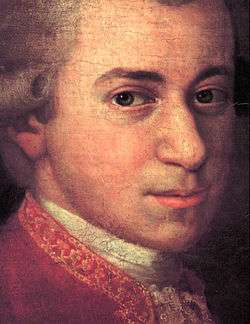Betulia liberata
Betulia liberata ("The Liberation of Bethulia") is the title of a libretto by Pietro Metastasio which was originally commissioned by Emperor Charles VI and set by Georg Reutter the younger in 1734. It was subsequently set by as many as 30 composers, including Niccolò Jommelli (1743), Ignaz Holzbauer (1752), Leopold Kozeluch (1780), Joseph Schuster (1787), Antonio Salieri (1821), and most famously Mozart (1771).
The Mozart is the best known, if only because the composer's output receives more examination. Composed in March to July 1771 when Mozart was 15 years old, K. 118 (74c) is a 140-minute "azione sacra" on a text by Metastasio tracing the story of Judith and Holofernes from the biblical Book of Judith. It was commissioned in March 1771 by Giuseppe Ximenes, Prince of Aragon, while Mozart and his father Leopold were on the way home to Salzburg from their first journey to Italy. It is the only oratorio Mozart ever wrote. Its two parts comprise sixteen arias, with solo or choral parts, scored for soloists, choir and orchestra. Not performed in Mozart's lifetime, La Betulia liberata is shaped stylistically to works by Leonardo Leo and Johann Adolph Hasse.
Both the Mozart and the Jommelli drew attention in 2010 when they were performed side-by-side at the Salzburg Whitsun and Ravenna festivals under the leadership of Riccardo Muti.
Mozart's setting
Roles
- Ozia, prince of Bethulia (tenor)
- Giuditta, widow of Manasses (alto)
- Amital, noblewoman of Israel (soprano)
- Achior, prince of the Ammonites (bass)
- Cabri and Carmi, chiefs of the people (sopranos)
- Bethulians (chorus)
Structure
First part
- Overtura
- recitative: Popoli di Betulia (Ozia)
- Aria #1: D’ogni colpa la colpa maggiore (Ozia)
- recitative: E in che sperar? (Cabri, Amital)
- Aria #2: Ma qual virtù non cede (Cabri)
- recitative: Già le memorie antiche (Ozia, Cabri, Amital)
- Aria #3: Non hai cor (Amital)
- recitative: E qual pace sperate (Ozia, Amital, chorus)
- Aria with chorus #4: Pietà, se irato sei (Ozia, chorus)
- recitative: Chi è costei che qual sorgente aurora (Cabri, Amital, Ozia, Giuditta)
- Aria #5: Del pari infeconda (Giuditta)
- recitative: Oh saggia, oh santa (Ozia, Cabri, Giuditta)
- Aria with chorus #6: Pietà, se irato sei (Ozia, chorus)
- recitative: Signor, Carmi a te viene (Cabri, Amital, Carmi, Ozia, Achior)
- Aria #7: Terribile d’aspetto (Achior)
- recitative: Ti consola, Achior (Ozia, Cabri, Achior, Giuditta)
- Aria #8: Parto inerme, e non pavento (Giuditta)
- Chorus #9: Oh prodigio! Oh stupor! (Chorus)
Second part
- recitative: Troppo mal corrisponde (Achior, Ozia)
- Aria #10: Se Dio veder tu vuoi (Ozia)
- recitative: Confuso io son (Achior, Ozia, Amital)
- Aria #11: Quel nocchier che in gran procella (Amital)
- recitative: Lungamente non dura (Ozia, Amital, chorus, Cabri, Giuditta, Achior)
- Aria #12: Prigionier che fa ritorno (Giuditta)
- recitative: Giuditta, Ozia, popoli, amici (Achior)
- Aria #13: Te solo adoro (Achior)
- recitative: Di tua vittoria (Ozia, Amital)
- Aria #14: Con troppa rea viltà (Amital)
- recitative: Quanta cura hai di noi (Cabri, Carmi, Ozia, Amital)
- Aria #15: Quei moti che senti (Carmi)
- recitative: Seguansi, o Carmi (Ozia, Amital, Cabri, Achior, Giuditta)
- Aria with chorus #16: Lodi al gran Dio (Giuditta, chorus)
Recordings
(Conductor, label, catalogue number, year)
- Leopold Hager, Philips, 422522-2
- Carlo Felice Cillario, A. Charlin, AMS 2627/8-2
- Mario Rossi, Opera d'Oro
- Peter Maag, Brilliant Classics, 99944 (also in earlier Complete Works box, 92540)
- Riccardo Favero, Brilliant Classics, 94496 (also in updated Complete Works box, 94051)
- Christoph Poppen, Deutsche Grammophon, DVD 4400734248
- Michi Gaigg, Challenge Records, Super audio CC72590, 2013
Settings by other composers
As a student of Antonio Salieri, Franz Schubert set "Te solo adoro", Anchior's aria from the second part, as a composition exercise for four voices in November 1812.[1] The exercise was first published in 1940, and having received 34 as number in the Deutsch catalogue, again in the New Schubert Edition in 1986.[2]
References
- ↑ Otto Erich Deutsch, Werner Aderhold and others (eds.) Franz Schubert: Neue Ausgabe sämtlicher Werke; Series VIII: Supplement; Volume 4: Franz Schubert: Thematisches Verzeichnis seiner Werke in chronologischer Folge Bärenreiter, 1978. ISBN 9783761805718 — pp. 27-28
- ↑ Alfred Mann (ed.) Franz Schubert: Neue Ausgabe sämtlicher Werke; Series VIII: Supplement; Volume 2: Schuberts Studien Bärenreiter, 1986. No. 39
External links
- Betulia liberata: Score and critical report (German) in the Neue Mozart-Ausgabe
- La Betulia liberata: Scores at the International Music Score Library Project
- Franz Schubert, with corrections by Antonio Salieri. Autograph of "Te solo Adoro" for SATB (D 34) at schubert-online.at by Austrian Academy of Sciences (OAW)
